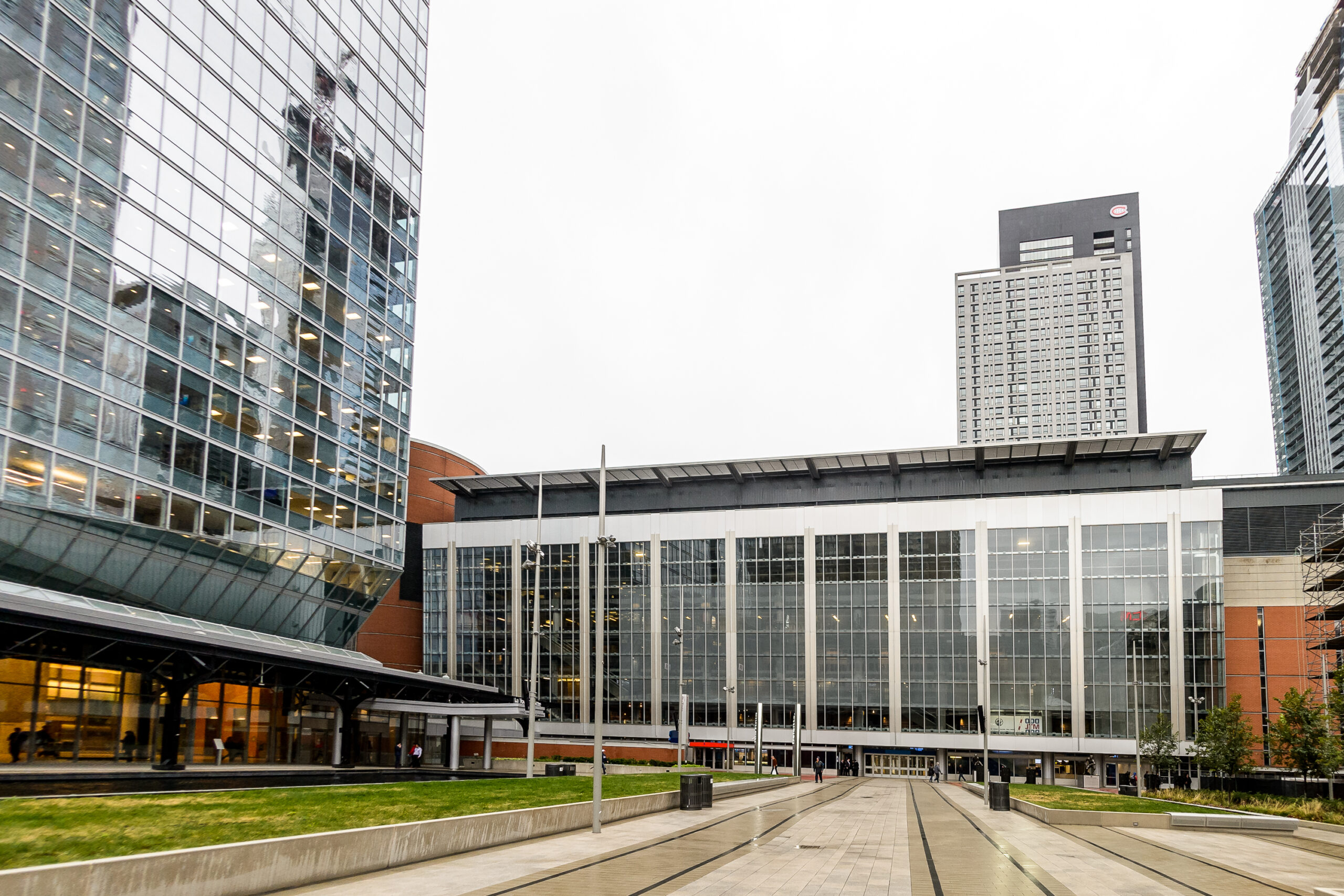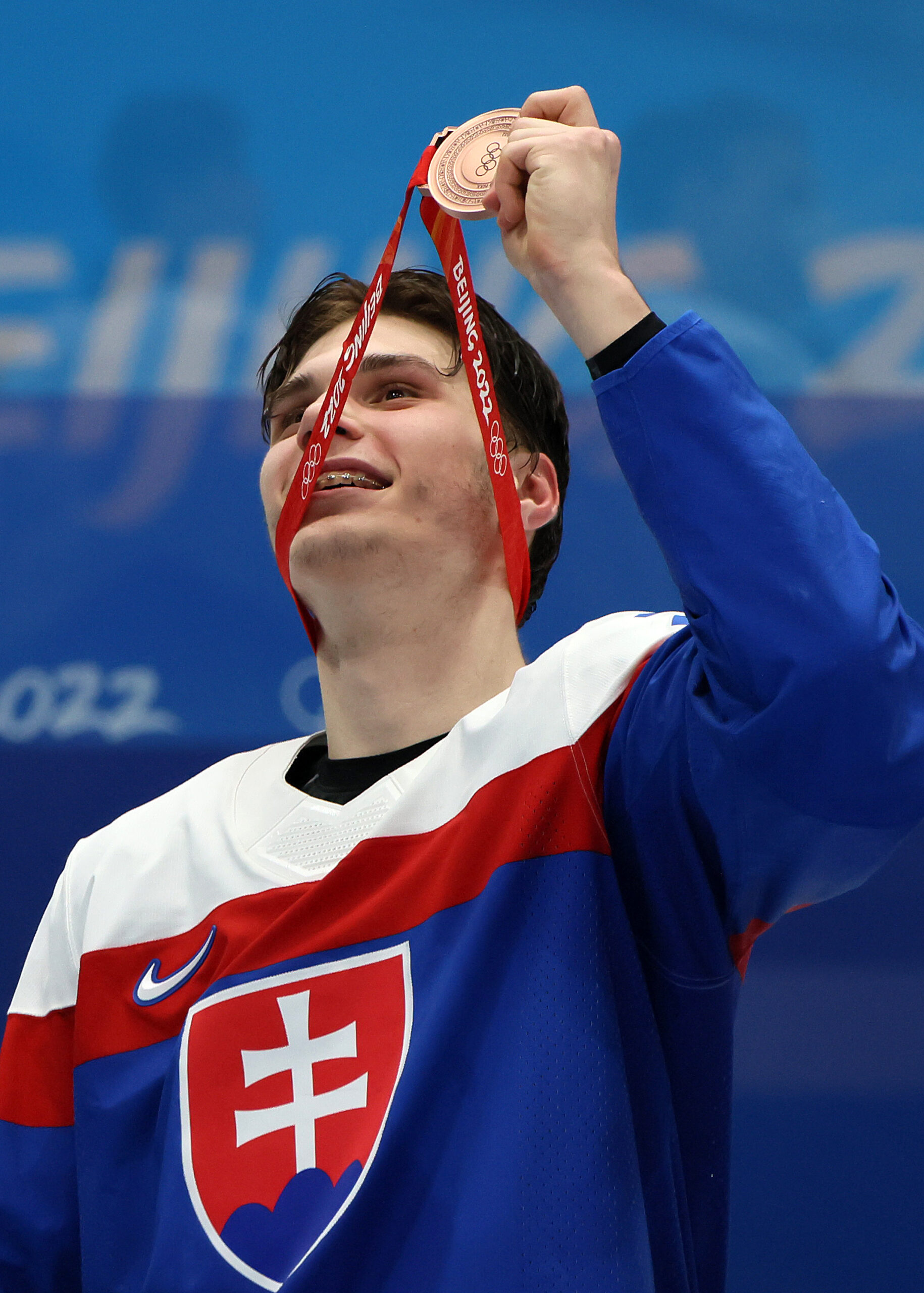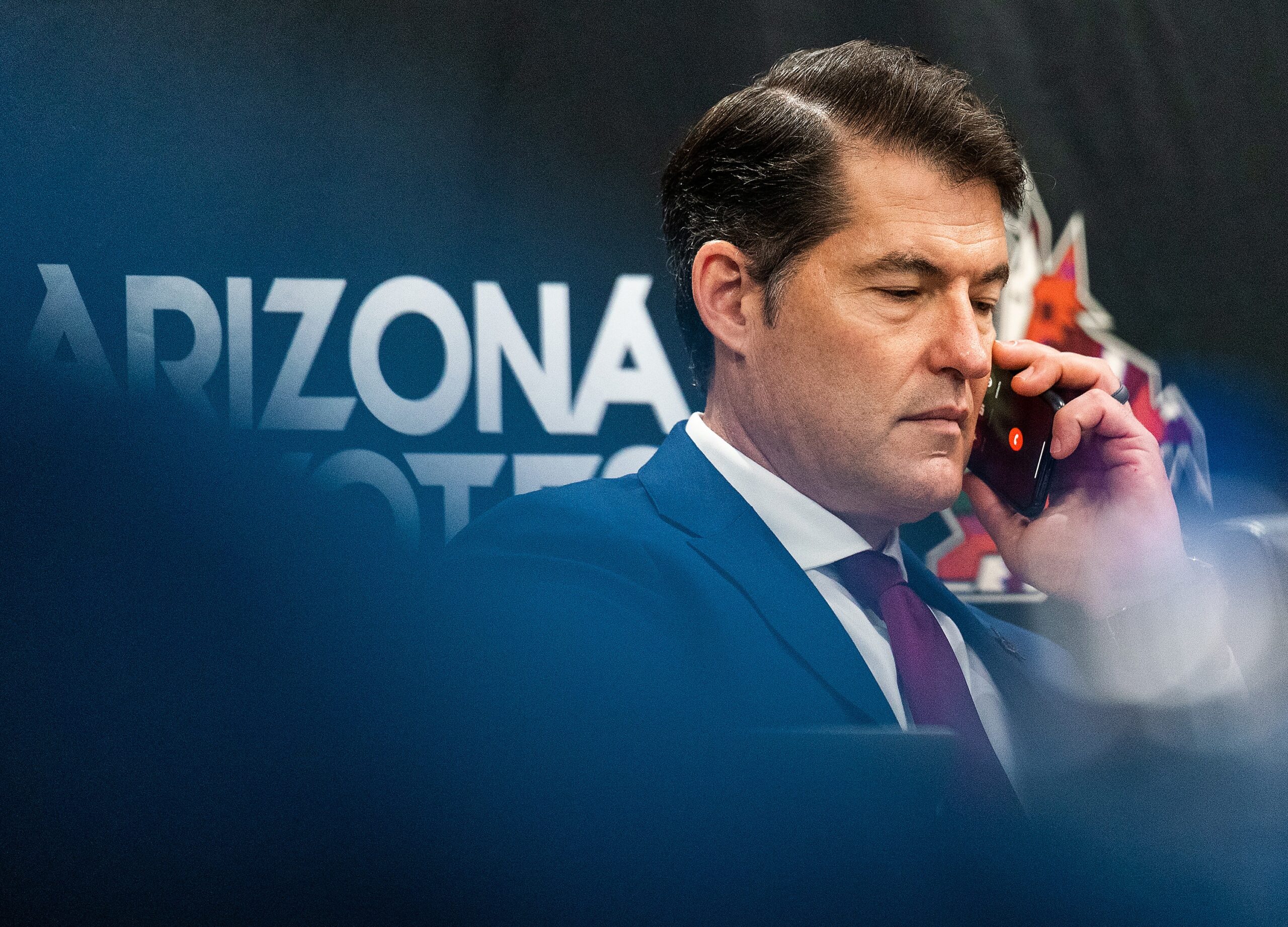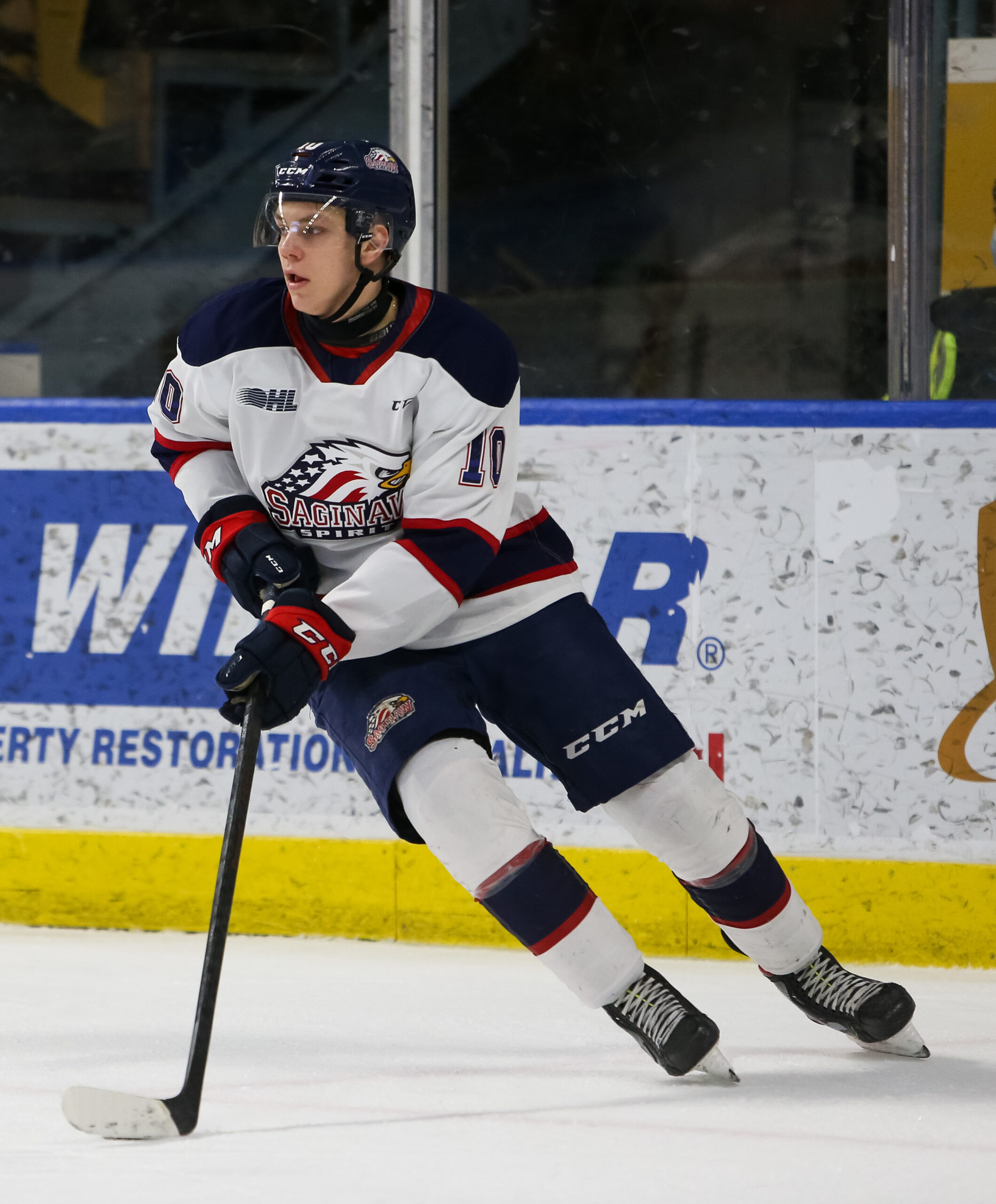© 2025 ALLCITY Network Inc.
All rights reserved.

Coyotes fans have endured a lot of pain over the past calendar year.
You screamed in anger or cried in anguish when a litany of popular players left the Valley last summer so that GM Bill Armstrong could strip this roster to its studs and acquire future assets.
You cringed when the team and the City of Glendale reached a breaking point that led to the Coyotes’ eviction from Gila River Arena at the end of the 2021-22 season.
You endured an agonizing 25-50-7 record that ended even more agonizingly when the Coyotes won their final three meaningless games to botch the season-long assignment.
You glowed with envy last summer as a Sunbelt team won its second straight Stanley Cup, and you sighed when another franchise in this corner of the country followed suit last month.
Take heart, Coyotes nation. The potential payoff is finally in sight.
As team president and CEO Xavier Gutierrez has noted, the NHL Draft is the Coyotes’ Stanley Cup. With seven picks in the top 45 and 10 overall, the management staff hopes that this will be the first in a string of watershed drafts that alters the fortunes of a long struggling franchise.
It won’t happen quickly, as Armstrong cautioned during a news conference on Friday. There don’t appear to be any franchise-altering players at the top of this NHL Draft, the Coyotes have a lot of needs and most draft picks will need several years of development before they are ready to push this team into playoff contention.
That said, you have to start somewhere. As a former scout, Armstrong has provided his staff with an opportunity to finally get off the blocks and into the race.
“The most frustrating thing you can imagine is being a scout with a great list and no picks,” he said. “They want to make picks and they know where we lie in the draft order. It’s an exciting time for us.”
The NHL will hold its annual entry draft on Thursday and Friday in Montréal. PHNX will be there to cover it with the sort of in-depth and comprehensive content that you won’t get from any other media outlet.
Here’s a primer to prepare you for our week’s worth of NHL Draft-centric shows, stories and events.

The particulars
Here is the NHL Draft schedule and some key additional information:
Thursday: Round 1 begins at 4 p.m. Arizona time.
Friday: Rounds 2-7 begin at 8 a.m. Arizona time.
Television: ESPN, NHL Network
US Stream: ESPN+
Draft order: Here is a link to all seven rounds.
Coyotes picks:
Round 1: No. 3; No. 27 (from Carolina); No. 32 (from Colorado)
Round 2: No 34; No. 36 (from Philadelphia); No. 43 (from San Jose); No. 45 (from New York Islanders)
Round 3: No. 67
Round 5: No. 131
Round 6: No. 163
PHNX will host a draft party at Four Peaks Brewery in Tempe beginning at 4 p.m. on Thursday. PHNX’s Steve Peters, Shawn DePaz and other staff members will be in attendance. ASU coach Greg Powers and Tucson Roadrunners coach Jay Varady will join as guests and Coyotes prospect Josh Doan will join via web link.
For more information, follow this link.
Our draft-day coverage will also include interviews with former first-round picks Danny Briére, Martin Hanzal, Mikkel Bødker, Connor Murphy, Barrett Hayton and Dylan Guenther. You can find all of those by following this link.

The prospects
Canadian Shane Wright, Americans Logan Cooley, Cutter Gauthier and Slovakian Juraj Slafkovský are the top forward prospects in the draft.
Slovakian Šimon Nemec, Czechia’s David Jiříček, Canadian Kevin Korchinski and Russian Pavel Mintyukov are the top defenseman prospects.
Canadian Tyler Brennan, Finland’s Topias Leinonen, Sweden’s Hugo Hävelid and Belarusian Ivan Zhigalov are the top rated goalies.
The order of selection is anybody’s guess and the variance in top analysts’ draft boards is an indication of how little consensus there is over the top pick, how close the top handful of players is in ability, and the lack of a generational talent in this draft.
Here’s a look at the NHL Draft boards for four analysts who have appeared on the PHNX Coyotes show. Three different players top their boards and the order after those players varies.
TSN’s Bob McKenzie has Slafkovský at the top.
TSN’s Craig Button has Wright at the top.
The Athletic’s Corey Pronman also lists Slafkovský at the top.
Daily Faceoff’s Chris Peters lists Cooley at the top.
You can find all of our prospect breakdowns from these four analysts by following this link.
Of course, all of this is just speculation and there are other factors to consider as well. The Canadiens are hosting the draft. When a team hosts the NHL Draft, there is often pressure to make a big splash, as several executives have noted.
Consider this: Long-presumed No. 1 pick Shane Wright grew up in Canada and played his junior hockey in Kingston, which is about 167 miles from Montréal, or about the same distance as Gilbert is from Flagstaff.
“If you don’t think there is pressure for the Canadiens to take Wright, you’re fucking nuts,” one executive said. “You’re going to have a lot of fans show up at the Bell Center in Wright jerseys and you’re going to announce to them that you’re taking some Slovakian kid they’ve never seen play? Imagine all the boos. You bet your ass there’s pressure.”
There has been some speculation that the Canadiens might consider trading out of the No. 1 slot, or that the New Jersey Devils might consider trading out of the No. 2 slot because the top three prospects are all potential centers and the Devils need defensemen badly. One executive pooh-poohed that idea.
“You ain’t trading the No. 1 pick when you’re hosting the draft and New Jersey ain’t trading No. 2 either,” the executive said. “It’s all just chatter.”
The executive has history on his side. Since 2000, the No. 1 and No. 2 pick in the NHL Draft have only been traded a combined three times and it hasn’t happened since 2003.
In 2003, the Florida Panthers traded the No. 1 overall pick and a third-round pick to the Pittsburgh Penguins for the No. 3 pick, a second-round pick and Mikael Samuelsson. Pittsburgh selected goalie Marc-André Fleury.
In 2002, the Panthers also traded the No. 1 overall pick to Columbus, which used it to select forward Rick Nash.
In 2001, the Islanders traded the No. 2 overall selection, forward Bill Muckalt and defenseman Zdeno Chara to Ottawa for Alexei Yashin. Ottawa selected center Jason Spezza.
We’ll see if the Canadiens or Devils break a long streak.

Could Coyotes trade down or up?
I asked Armstrong if the Coyotes might consider trading down from the No. 3 pick if it allowed them to add an extra asset, or if they might consider packaging their two other first-round picks or their four second-round picks in some configuration to move up in the first round.
This was his response.
“I think both,” he said. “We’re gonna look at every scenario when we get in there. We’re gonna go through them all. We’re thrilled to be where we are. We’ve taken the pain and now it’s time to go make some hay and let’s see what we can get done.”

What about Jakob Chychrun?
Defenseman Jakob Chychrun made it plain that he was not happy with the direction of the team when he spoke on break-up day after the regular season.
“I want to win more than anybody,” he said. “Everybody says that, but I truly believe it, and so, at times, that can be tough.
“I’ve been here my whole career. I absolutely love it here, and it seems like every time we get to a point where it looks like we’re gonna be getting there, it just gets torn down again. That was kind of tough on me a bit this year, just naturally as a human being and a competitive person.”
I have noted previously that you can’t blame Chychrun, 24, for wanting to win now. He has entered the prime of his career and the Coyotes are in the midst of another rebuild while the team prepares to move from 17,125-seat Gila River Arena to Arizona State University’s 5,100-seat multi-purpose arena.
Chychrun hasn’t gone so far as to demand a trade, but you didn’t have to be a skilled tea-leaves reader to discern his intent when I asked what would happen if the Coyotes were not able to trade him at the draft.
“I don’t know,” he said. “I’m signed for three more years so we’ll see. The trajectory of where the team is going and a lot of that stuff is important to me. I want to be in a position where I’m getting ready to play a week from now, not packing up and leaving the boys. That’s really the biggest thing for me is just having that competitive drive in me; a burning desire to win a Stanley Cup.”
Up until recently, Armstrong had said that he intended to explore the trade route at the NHL Draft when more teams could get involved than were able to do so at the trade deadline. On Friday, Armstrong’s tune changed a bit when asked if there had been any movement on the Chychrun trade front.
“It hasn’t changed much,” Armstrong said. “Jakob is going to come back and play for us next year at this point. We’re always taking offers if it’s something that’s going to better our team. We’ll make those calls at the draft or any other time afterwards, but right now, he’s going to come back and play for us, and we expect him to be a big part of our team next year.”

Who’s hot, who’s not?
Canada will produce the most draft picks, just as it does every year, but that number has been shrinking over the past decade and there are some analysts who believe that Canadian prospects could come from slightly less conventional quarters.
Multiple draft analysts have suggested that this could be a down year for the OHL while those same analysts believe that the WHL could have a banner year. As for the QMJHL, Armstrong harkened back to an early lesson that he learned in St. Louis when Larry Pleau, now a Coyotes senior advisor, was the Blues GM.
“He’d always say to me, ‘There’s always one good player every year that comes out of Québec,'” Armstrong said. “He was adamant about it and said, ‘We’d better go find him,’ so I don’t necessarily fall into these traps that you hear from all the chatter.
“I mean, there are stronger and weaker years for every league. That’s just the way it is. It’s cyclical, but I think people can convince themselves that it’s a bad year in one league when in truth there’s always players. Maybe it’s in the third round that you find those guys, but there’s always players. Just because it’s a down year and you get disappointed, you can’t just completely write off a league. There’s going to be someone who plays from a league that’s not that strong so you’ve just got to find that player.”
Speaking of finding players, the Coyotes scouting staff has spent an inordinate amount of time in Europe this season. Director of amateur scouting Darryl Plandowski was in Sweden for three weeks straight at one point this season, and Armstrong joked that the staff had sat in every dingy rink in Slovakia to scout players.
Those two examples are instructive because Sweden could have a big year at the draft and Slovakia has two of the league’s top handful of prospects, a shining example of the recent strides that program has taken under Slovakia hockey president and former NHL player Miroslav Šatan.
On the domestic front, the USA NTDP, and by extension the USHL, is expected to have another big year, with Cooley and Gauthier highlighting a deep cast of potential high picks.

The Russian conundrum
There are several intriguing Russian prospects in this NHL Draft, including forwards Danila Yurov, Ivan Miroshnichenko and Mintyukov (shown above). Whether they go as high as normal projections would have them may depend on the ongoing conflict in Ukraine.
Ever since Russia invaded its neighbor in February, NHL executives and scouts have warned of a potential impact on Russian born players when it comes time for the draft. The recent detainment of Russian goalie Ivan Fedotov only fueled such rumors, and that situation gets scarier with each passing day.
There is even speculation that Russia won’t allow drafted players to come to the NHL, given the friction with the US.
All Armstrong would say is that the Coyotes continue to gather information, but I reached out to six NHL executives on the condition of anonymity. Here is a sampling of their thoughts on how the drafting of Russian players might proceed.
Executive 1: “I think it is all over the map. We have some apprehension but certainly won’t rule it out at some point in the draft. It is fascinating for sure and we will be watching other teams closely.”
Executive 2: “I can’t speak on any other teams’ behalf, but we are doing our list as if things are normal.”
Executive 3: “It’s tough to tell but we feel the Russian players will be at a discount because of this situation so we are not disregarding them. We think they will provide better value later in the draft. I think they might fall a little but some teams will also be looking for value.”
Executive 4: “Russian players always present a risk and I think people lose sight of that. The conflict doesn’t help but there are always concerns about whether they will come to play or stay in the KHL to earn a little more money. I still think that if the talent is there, teams are going to take that risk.”
Executive 5: “To be honest, we’re still trying to gather as much information as possible, and the latest information possible, so we can update our plan. It’s so fluid right now. You can’t ignore talent, but you have to weigh the risk in the calculation when deciding when it’s appropriate to take those swings.”
Executive 6: “I’m sure there’s some concern; most teams will be gathering more information. It’s possible for sure that players will drop on draft boards because of that concern. It always comes down to how strongly you feel about the player and what you believe the risk is. This will still be evolving.”
Follow Craig Morgan on Twitter
Comments
Share your thoughts
Join the conversation



